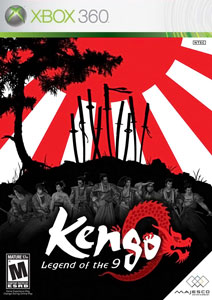Kengo (剣豪) is a series of video games developed by Genki. Kengo is considered a spiritual successor to the Bushido Blade game series for the PlayStation.
| Kengo | |
|---|---|
 Kengo: Legend of the 9 cover art | |
| Genre(s) | Fighting |
| Developer(s) | Light Weight Genki |
| Publisher(s) | Crave Entertainment Majesco Entertainment |
| Platform(s) | PlayStation 2, Xbox 360 |
Games
editKengo: Master of Bushido
editKengo 2: Legacy of the Blade
editThe second game in the Kengo series was released for the PlayStation 2 in Japan on June 27, 2002. It was released in Europe on February 14, 2003 under the title Sword of the Samurai. It features a character creation feature and over 100 detailed swords to choose from. Published by Ubisoft. It was not released in North America.
In Japan, Famitsu gave the sequel 30 out of 40.[1] The game received a 64% overall review score from Futuregamez.[2]
Kengo 3
editThe third game in the Kengo series was released for the PlayStation 2 on September 22, 2004. Featuring much improved graphics and a simplified fighting system from Kengo 2. It was released only in Japan.
Kengo: Legend of the 9
editReleased for the Xbox 360 on September 7, 2006, Kengo: Legend of the 9 (Kengo: Zero in Japan and Europe) was developed by Genki and published by Majesco Entertainment.[3] It is the fourth and last game in the series.
In the game there are a total of 10 playable characters:
- Historical: Miyamoto Musashi, Yagyū Jūbei Mitsuyoshi, Chiba Sanako (famed female master swordsman born into a famous family of swordmaster in the Edo era), Itō Ittōsai, Okada Izō, Okita Sōji, Sasaki Kojirō, Sakamoto Ryōma, Horibe Yasubei. Jion (unlockable) Although thought to be a fictional character, Jion may in fact refer to Sōma Shiro Yoshimoto, also known as Jion, the founder of Nen-ryu.
Reception
edit| Aggregator | Score |
|---|---|
| Metacritic | 38/100[4] |
| Publication | Score |
|---|---|
| Game Informer | 2/10[5] |
| GameSpot | 3/10[6] |
| GameSpy | [7] |
| GamesRadar+ | [8] |
| GameTrailers | 4.8/10[9] |
| GameZone | 3.5/10[10] |
| IGN | 3.5/10[11] |
| Official Xbox Magazine (US) | 3.5/10[12] |
Kengo: Legend of the 9 was panned by critics. The game received "unfavorable" reviews according to video game review aggregator Metacritic.[4]
References
edit- ^ "プレイステーション2 - 剣豪2". Famitsu. Vol. 915. June 30, 2006. p. 92.
- ^ "Sword of the Samurai Review". Futuregamez. Archived from the original on 2012-04-26. Retrieved 2011-12-06.
- ^ "Kengo: Legend of the 9 (Xbox 360)". TeamXbox. Archived from the original on March 21, 2012. Retrieved January 7, 2015.
- ^ a b "Kengo: Legend of the 9 for Xbox 360 Reviews". Metacritic. Retrieved January 7, 2015.
- ^ Juba, Joe (December 2007). "Kengo: Legend of the 9". Game Informer. No. 176. Archived from the original on January 11, 2008. Retrieved January 7, 2015.
- ^ Todd, Brett (September 25, 2007). "Kengo: Legend of the 9 Review". GameSpot. Retrieved January 7, 2015.
- ^ Steinberg, Steve (October 1, 2007). "GameSpy: Kengo: Legend of the 9". GameSpy. Retrieved January 8, 2015.
- ^ Mardsen, Ken (September 28, 2007). "Kengo: Legend of the 9 review". GamesRadar. Retrieved January 8, 2015.
- ^ "Kengo: Legend of the 9 Review". GameTrailers. October 23, 2007. Retrieved January 8, 2015.
- ^ Romano, Natalie (September 30, 2007). "Kengo: Legend of the 9 - 360 - Review". GameZone. Archived from the original on February 24, 2008. Retrieved January 8, 2015.
- ^ Craddock, David (September 13, 2007). "Kengo: Legend of the 9 Review". IGN. Retrieved January 7, 2015.
- ^ "Kengo: Legend of the 9". Official Xbox Magazine. December 2007. p. 76.